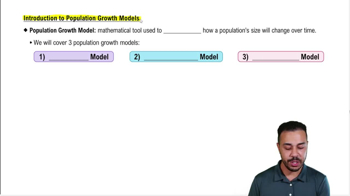Here are the essential concepts you must grasp in order to answer the question correctly.
Density-Dependent Factors
Density-dependent factors are environmental influences that affect population size in relation to the population's density. These factors, such as food supply, waste concentration, and disease, become more significant as the population increases, leading to increased competition and mortality rates. Understanding these factors is crucial for analyzing population dynamics and ecological balance.
Recommended video:
Density-Dependent Factors
Population Growth Models
Population growth models, such as the logistic growth model, illustrate how populations grow in relation to resource availability and environmental limits. The model shows that populations initially grow exponentially but eventually level off as they reach carrying capacity due to limiting factors. This concept is essential for understanding how density-dependent factors influence population size over time.
Recommended video:
Introduction to Population Growth Models
Carrying Capacity
Carrying capacity refers to the maximum number of individuals that an environment can sustainably support. It is determined by the availability of resources such as food, water, and habitat. When a population exceeds its carrying capacity, density-dependent factors like resource depletion and increased competition lead to a decline in population size, making this concept vital for ecological studies.
Recommended video:
Estimating Earth’s Human Carrying Capacity

 Verified step by step guidance
Verified step by step guidance


